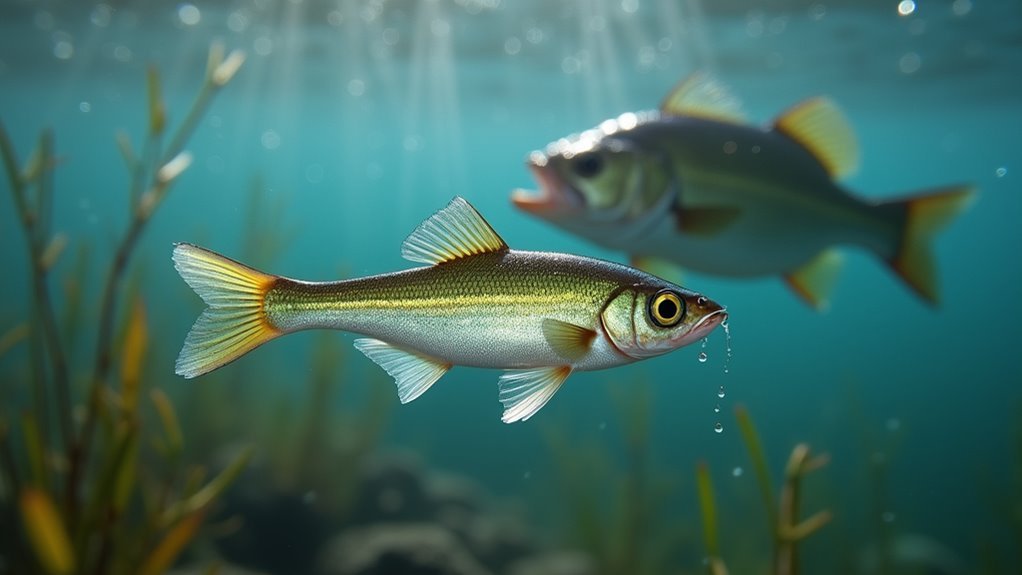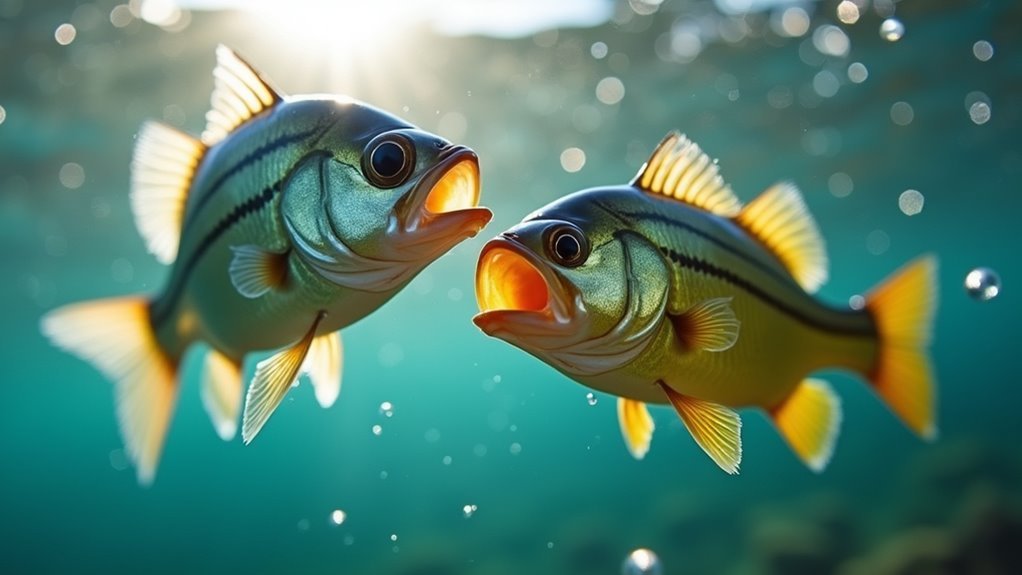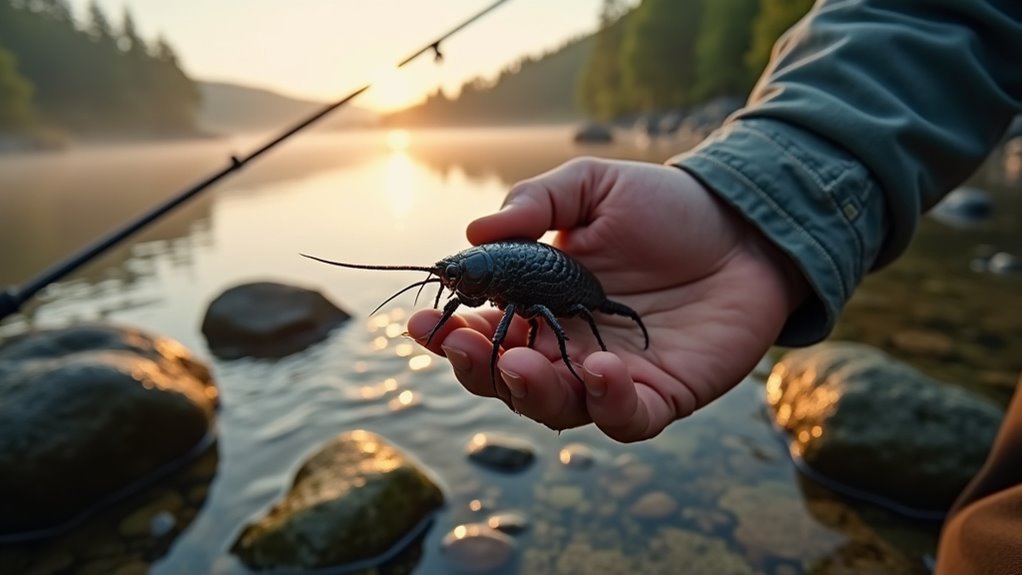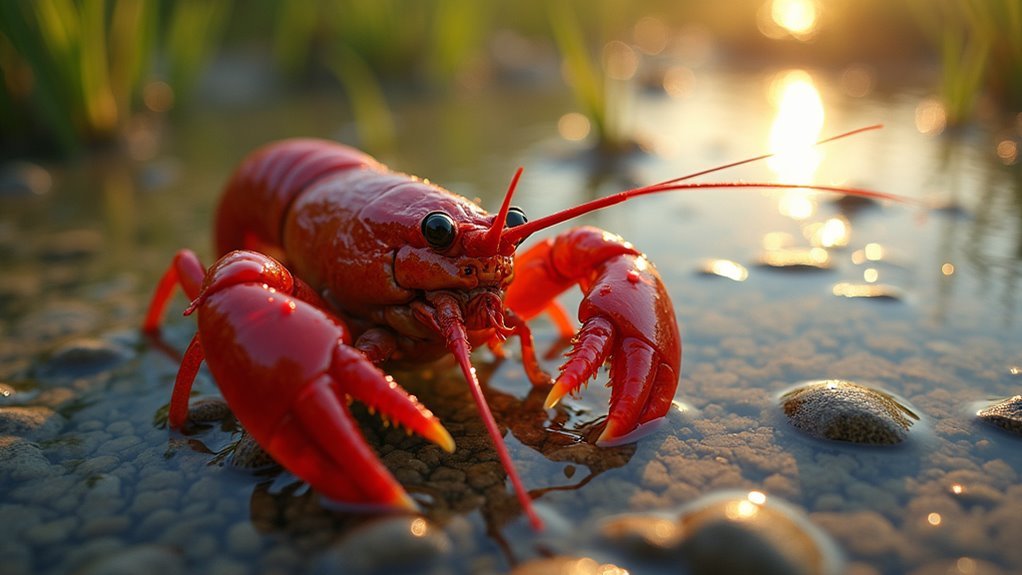We’ve found eight live baits that consistently land bass when artificial lures fail. Minnows offer simplicity and effectiveness, while shad and shiners attract trophy-sized catches. For smallmouth, madtoms work magic in rivers, and hellgrammites deliver despite their scary appearance. Crawfish and nightcrawlers trigger natural feeding instincts, while frogs excel in vegetation. Don’t overlook bluegills for targeting monster bass. These natural offerings provide movement and scent that even the most stubborn bass can’t resist.
Minnows: The Classic Bass Bait That Never Fails

Simplicity often leads to success in bass fishing, and nothing proves this better than the humble minnow. We’ve spent countless mornings watching bass smash these little swimmers when fancy lures got ignored.
You can buy minnows at bait shops or catch your own with a seine net in shallow water. We’ve had great luck sweeping through schools near shorelines. For the best presentation, hook them through both lips from bottom up—keeps them lively longer.
Try a split shot rig near cover or use a bobber to suspend them naturally. When they start looking sluggish, swap ’em out. Fresh bait catches fish!
Shad and Shiners for Trophy-Sized Bass

When targeting trophy-sized bass, shad and shiners rise to the top of our bait list. These baitfish are irresistible to larger bass in deeper waters, especially striped bass that can’t say no to a lively shad.
We’ve had our best luck using a simple rig—barrel swivel with an egg sinker and 36-inch leader. Position it a few feet off the bottom where the big ones lurk.
Catching them requires some work with a cast net. We’ve spent many evenings around dams and rocky areas tossing nets. Sometimes we’ll hang a lantern at night to draw them in. The effort pays off when that trophy bass strikes!
Madtoms: The Secret Weapon for Smallmouth

If you’re hunting specifically for smallmouth bass in the Southeastern U.S., madtoms might just be your secret weapon. These mini-catfish pack a punch that bigger bass can’t resist, and their size keeps smaller fish from nibbling your bait.
To maximize your madtom success:
- Flip rocks in shallow rivers to find them (watch those venomous spines!)
- Hook through both lips from bottom up for the most natural presentation
- Target pools near riverbanks and logjams where smallmouth lurk
We’ve pulled some monster smallies using madtoms when nothing else worked. They’re worth the extra effort to catch.
Hellgrammites: Turning Over Rocks for Big Catches

Despite their scary appearance, hellgrammites rank among the most effective live baits you’ll ever use for bass fishing. These Dobsonfly larvae might give you the creeps, but bass can’t resist them!
We’ve found flipping rocks in streams with a buddy works best—one person lifts while the other scoops. They’re surprisingly low-maintenance too. We once kept a batch alive for three weeks in a container with natural brush and shallow water.
When fishing, hook them behind the collar and let the current do the work. We’ve pulled some monster smallmouths from cover using this technique!
Crawfish: Irresistible Natural Prey for Largemouth

Crawfish rank among the absolute best live baits you can throw at a hungry largemouth bass. These little crustaceans mimic a bass’s natural prey perfectly, triggering those predatory instincts like nothing else.
Catching your own crawfish is surprisingly simple:
- Flip over rocks and logs in shallow streams
- Use a minnow trap baited with bread in creek bottoms
- Employ a net and stick to guide them into capture
We’ve found bass simply can’t resist a properly presented crawfish. Their erratic movements and natural appearance make them deadly effective, especially around rocky areas where bass are hunting.
Night Crawlers: Simple Yet Deadly Effective
Night crawlers might seem like the humble workhorses of the bait world, but don’t let their simplicity fool you. These wiggly wonders are bass magnets when rigged properly. We’ve caught countless largemouth using them with an ultralight setup and 6-pound mono.
Hook your crawler through the tip, leaving the barb exposed. Then give it a gentle jig to create that irresistible movement. I once landed a 5-pounder near a fallen log using this exact method during a summer downpour.
The beauty of night crawlers? They’re available everywhere and catch practically everything that swims.
Frogs: Master the Art of Fishing Heavy Cover
While night crawlers work wonders in open water, we’ve found that frogs reign supreme when bass hide in thick vegetation. Massive bass can’t resist these jumpy treats, especially after a heavy rain when frogs are most active.
Frogs become bass magnets in vegetation, particularly after rainfall when these amphibians are naturally more abundant.
For frog fishing success:
- Rig through the forelegs to maintain natural movement
- Cast near lily pads and dense vegetation, then let the frog sit
- Create erratic movement with quick rod jerks when needed
We once pulled a 7-pounder from under a mat of weeds using this technique. The explosive strike nearly yanked the rod from my hands!
Bluegills: Using Bass’s Natural Prey Against Them
When big bass are proving difficult to tempt with artificial lures, we’ve found that using their favorite meal against them can be devastatingly effective. Bluegills are perfect for this strategy – they’re abundant and irresistible to lunker bass.
We catch our bluegills using small hooks with worms in shallow water. Keep them alive in a bait bucket on the side of your boat. Hook them through the back just behind the dorsal fin to keep them swimming naturally.
Fish these bluegill baits near fallen trees or weedlines where big bass lurk. We’ve pulled 8-pounders from spots that wouldn’t give up a thing to plastic worms!
Frequently Asked Questions
How Long Can Live Bait Survive in My Tackle Box?
We can’t keep live bait in a tackle box for long. Most need water to survive – minnows and shad just hours, while nightcrawlers might last days in proper bedding with air circulation.
Are There Seasonal Considerations When Choosing Different Live Baits?
Like nature’s calendar, we should adjust our bait choices seasonally. In spring, we’re using crawfish and worms. Summer calls for bluegills and frogs. Fall, we’ll want shad. Winter, we’ll downsize to minnows for sluggish bass.
Can I Use Saltwater Bait Species for Freshwater Bass Fishing?
We don’t recommend using saltwater bait for freshwater bass. While some might work temporarily, they’ll quickly die in freshwater. It’s best to stick with native freshwater species that naturally occur in bass habitats.
What’s the Best Way to Transport Live Bait Long Distances?
Like marathon runners who need perfect nutrition, our live bait needs proper transport systems. We’ll use aerated coolers with temperature control, minimal handling, and regular water changes to keep our finned friends lively during long trips.
How Do Water Temperature Changes Affect Different Live Bait Effectiveness?
Water temperature changes drastically affect our bait choices. In cold water, we’ll find minnows and nightcrawlers more effective, while in warmer temperatures, crawfish and bluegills become more active and enticing to bass.
Conclusion
We’ve shared our top live baits that have helped us land countless bass over decades on the water. Isn’t it amazing how these natural options consistently outperform even the fanciest artificial lures? Whether you’re rigging up minnows at dawn or hunting hellgrammites along rocky shores, these proven baits will boost your success. Remember, the best anglers adapt to conditions, so keep this guide handy and let these live baits do what they do best—catch bass!